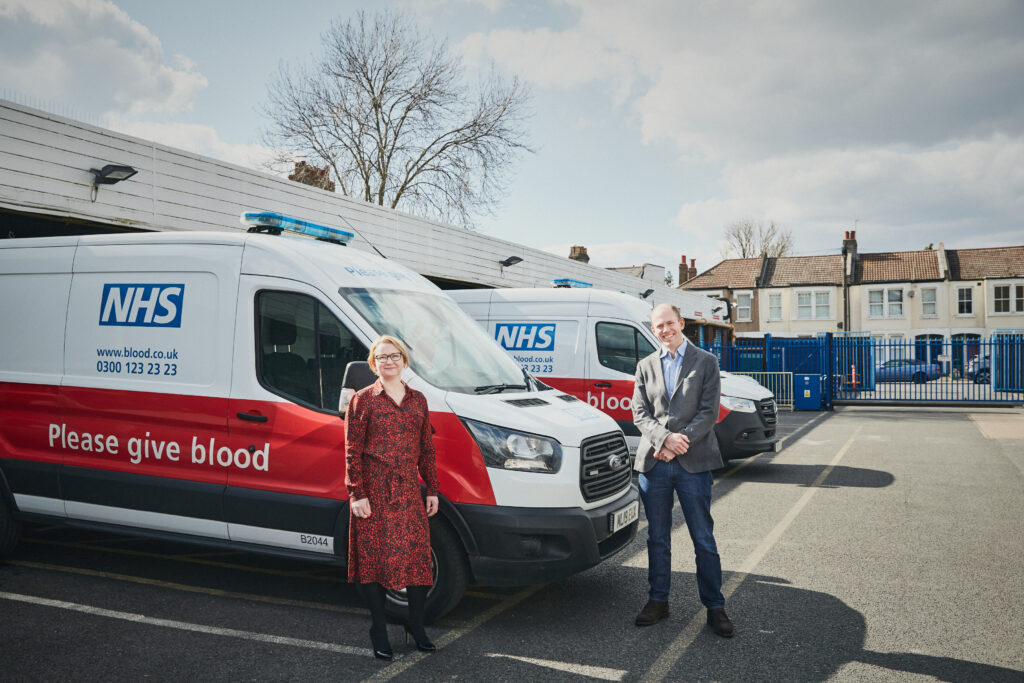Technology Driving Blood Supply

THE WORK OF NHS BLOOD AND TRANSPLANT KEEPS PEOPLE ALIVE. WENDY CLARK, CHIEF DIGITAL INFORMATION OFFICER, AND DAVID ROSE, DIRECTOR OF DONOR EXPERIENCE, TELL US HOW NEW CONSUMER-FACING TECHNOLOGIES AND A DEEP DIGITAL TRANSFORMATION AIMS TO HELP NHSBT DELIVER EVEN MORE FOR DONORS, EMPLOYEES AND PATIENTS.
NHS Blood and Transplant (NHSBT) could, quite poetically, be described as the beating heart of the NHS. The source and supply of blood, organs and tissues is vital to meeting the needs of our hospital patients – and to ultimately saving and improving lives.
Every year, NHSBT collects up to 1.5 million voluntary blood donations in England. But guaranteeing the reliable delivery of this blood to hospitals country-wide represents a significant supply-and-demand challenge. On top of keeping this complex system running, NHSBT is also continuously striving to better its service; from improving a donor’s experience, through to getting the right blood components to the right patients more efficiently.
Technology is a crucial part of the puzzle for NHSBT and its dedicated team. Strategically, the organisation has put technology at the core and it has committed budget and people to a series of ongoing transformation programmes. In January 2020 it appointed Wendy Clark, previously a senior executive for NHS Digital, as its Chief Digital Information Officer.
“We couldn’t do what we do without technology,” Clark tells Tech For Good. “The logistical nature of what we do would make it impossible to try, and it also allows us to reach out to donors and attract them in different ways. Everybody who works for NHSBT touches technology in some way in order to communicate and collaborate.”
Clark oversees blood supply technology projects largely focused on two priorities: to enhance the donor experience end-to-end, and to extract NHSBT from legacy infrastructure so that it can maintain and improve its processes and services in the future. It is a mix of short- and long-term programmes which will collectively affect every element of the NHSBT operation. It is technology, coupled with amazing donors, driving blood supply.
Saving and improving lives through the right mixture of donor types is key for NHSBT, which is why a lot of tech focus is on the donor experience. The UK model of altruistic donations means extra care and attention is afforded to donors – donation in other countries can be based on payment to citizens. David Rose was last year appointed as NHSBT’s first Director of Donor Experience to align the organisation and its objectives in this area.
Rose’s background is in the private sector and he has led customer loyalty programmes for global brands such as Virgin Atlantic and Starbucks. He was recruited by NHSBT to drive a renewed focus on its donors and their experiences with the aim of building a donor base right for the future.
“PPE, masks, gowns – you can manufacture all of that, but no hospital or country can manufacture some of the life-giving elements of what we use in our bodies, such as our blood,” says Rose. “So today we still rely on the generosity of our donors to donate so that our hospitals can continue to treat patients.”
Donor engagement is a fundamental part of the donor experience; this covers everything from marketing campaigns for new donor acquisition to direct engagement with donors through NHSBT’s booking portal and app.

When it comes to marketing, NHSBT increasingly adopts a hyperlocal approach to target donors with in-demand blood types at donation centres where there are appointment slots to be filled. On the tech side a major investment underway is the upgrading of the portal and app that donors then use to book appointments. Over 75% of donor appointments are made through these channels. A new-look, improved service founded on a human-centred design approach will go live this year.
“The application will have things built into it like improved ability to book appointments and accessibility enhancements, and the whole design of the app is going to look and feel a little bit different,” says Clark. “The red and white colours that you see throughout all of our digital technology are great from an organisational branding perspective, but they’re not necessarily the most accessible when it comes to digital.
“We’re also replatforming the app on modern, scalable technology, so that when we get lots of traffic we don’t need to do anything – the platform will scale with no intervention from any of the tech folks. It will make a massive difference initially, but then it also will be the enabler for personalisation. If we want to send information out to our donors, we will be able to do that through the portal and the app. So it’s a real platform for lots of the improvements that will come over the coming years.”
Hippo Digital has been one key development partner in NHSBT’s Donor Experience Product Centre – the function where new products like the donor app and portal are created. Hippo worked with NHSBT’s internal development teams to define the project roadmap, deploying its own people-centred design methodology and supporting the replatforming of the technology.
Hippodigital
“Hippo Digital has been instrumental in the delivery of both the app and changes to the portal,” says Clark. “Hippo has done this before, having worked across other areas of the NHS. It helps when you get a team of people who come on board and they know what good looks like in this space. It means we’re not having to set down standards and train people.”
As Clark highlighted, one ambition for NHSBT is to deliver a more personalised service to donors. The organisation’s current methods of managing its donor base are effective but donors are still often treated as a cohort, with the same messages sent out to large groups of people. The updated app and portal will go some way to offering personalised experiences but NHSBT is undertaking a broader piece of work it calls the “contact strategy”.
To get a 360-degree view of a donor and all the interactions with that individual, NHSBT is updating its CRM (customer relationship management) capability, aggregating as much data as possible from different sources. It also wants to reduce friction for users by offering automation tools and potentially chatbots, all of which plug into the system and offer a single “pane of glass” for NHSBT customer experience staff. Previously customer data sat in different locations and wasn’t utilised effectively.
“Our donor carers, who do most of the legwork in the centres, taking your blood and looking after people, will be equipped to understand actually what the background of the donor is,” says Rose. “That means we can make sure that we have the right number of new donors throughout the day, because those first-time donors require a little more care and attention, and helped through their first steps in donation.”
Technology change is even improving the process of blood collection. NHSBT has 23 fixed donation centres across the country and 50 mobile blood collection teams who operate thousands of community-based sessions each year. Clark describes the technology used by donor carers as “archaic” but this is set to change with the implementation of Session Solution; a mobile, connected solution to increase efficiency and vastly reduce paper usage.
Session Solution has been piloted at three sites to great success and will be rolled out across NHSBT’s mobile collection centres before the end of 2021. Data indicates that Session Solution will cut most donor journey times and NHSBT believes its adoption will also improve front-line morale and increase donor satisfaction.
“If you’ve ever given blood, you’ve probably turned up and somebody’s had bits of paper and a highlighter pen, and that’s how you get checked into the session,” says Clark. “This will make a real difference to the way our collection staff operate. It’s a new, modern solution that they can use to check donors in.”
Gennaro, the software underpinning Session Solution, was coded by Savant, a long-term partner to NHSBT. Savant’s primary engagement with NHSBT is around PULSE, the control system for blood management which was first implemented in 1996 and remains a critical infrastructure for the blood supply process today. PULSE controls everything from the management and enrolment of donors to laboratory testing, labelling and stock tracking as blood is dispatched to hospitals.
Savant
“It’s a spider at the centre of a web of everything that we do,” says Clark. “What it actually is, is about 80 applications which sit on top of a database and various other bits of infrastructure. And Savant are the PULSE programme in some ways. They do all of the engineering around the application and the database, and we work with them on the infrastructure side. There would be no blood supply tech if it weren’t for Savant, and in many ways, Savant are almost part of NHSBT.”
NHSBT, Savant and other partners are currently working on modernising PULSE and the wider IT stack in what Clark says is the organisation’s biggest technology mission. The Blood Tech Modernisation programme, which officially kicked off at the beginning of 2021 and will take five years, is a transformation initiative to “deliver the stabilisation and security of blood IT” and lay the groundwork for a cloud-first future.


In building a modern IT stack, NHSBT is carrying out remediation work on its database, database servers and the PULSE applications themselves. It will also be changing the way it integrates with that system so data can be consumed from other applications and services more readily via an API integration layer, opening up NHSBT and its systems for wider benefit. A long-standing partner in this area has been Cisco, which in multiple ways has helped NHSBT move to a hybrid cloud model.
NHSBT uses Cisco’s Multi-Cloud Architecture, which is composed of Cisco ACI Software Defined Networking with Hyperflex HCI deployed at edge sites and inside two data centres. The solution is provisioned, managed and maintained proactively via Cisco’s Intersight software and provides an always on, highly available and easily scalable platform for critical NHSBT applications. The solution will also be used to provide an extension of Cisco resources into the public cloud.
“Cisco provides us with whole solutions rather than products, and that makes our job a lot easier because we have quite a small in-house technology services function really and anything that can make their products easier to work with is very helpful for us,” says Clark. “There’s really deep expertise you get from Cisco and we’ve got a good and solid account team, and they’re always very helpful at value-add.
Cisco
“Legacy technology is a problem for NHSBT, as it’s a problem for many other organisations. We find ourselves in situations where our data is in some ways trapped inside a monolithic legacy system and getting access to that data to use through other applications has been tricky. That’s why we have the Blood Tech Modernisation programme going, so that we can liberate that data and get access again.
“By the time we get to the end of this modernisation journey, we don’t want to invest in the infrastructure again. When we get to the next five-year upgrade, we should be able to easily move to infrastructure-as-a-service and continue on that journey and reduce our data centre footprint further.”
***
It is indeed a journey that NHSBT is on, to maintain and improve this critical national service for the long-term. The organisation’s work has been eye-opening for Rose – not only is he relatively new to his role, but he’s also new to donating having previously been unable to enrol because of the amount of travel involved with his work. Now a regular donor, Rose understands the sense of togetherness in the blood donation community.
At the final stage of the donor experience, when recognising and thanking donors, NHSBT is taking extra steps to build that community feel. A follow-up message to donors thanks them for their participation and lets them know which hospital their blood has been issued to. Notable milestones are marked, for example if a donor has reached their fifth, tenth or even their hundredth donation. Before COVID-19 struck, NHSBT ran events to get donors together and recognise their role”, and during the pandemic it has launched a series of popular virtual community groups. It is a wholesome mission to look after its own and attract the 135,000 new donors it needs every year to continue its work.
“It really is fantastic,” says Rose. “You’re part of this community; it’s not just you giving blood, it’s a group of fantastic people giving blood. And that’s really something that you’re very proud to be a part of. Personally, I like to make sure when I walk into work, or dial in to work these days, I’m contributing something valuable. And to know that my work has a social purpose, a contribution so valuable, especially in these times of the pandemic, is really, really rewarding.
“I’m particularly excited about the opportunity through online or mobile-based experiences, and the self-service element. In an ideal world for me and my teams, we almost want to take a step back – it’s the donors that do all this valuable work. They’re the ones that are helping the patients, we’re there just helping them do that. And so, the opportunity with digital experiences is really to empower our donors to do this themselves, effortlessly.”
Clark is equally enthusiastic about the work NHSBT is undertaking. She was recently involved in its efforts to collect plasma for clinical research into treatments for COVID-19, a huge effort that was able to progress at speed only because of NHSBT’s technology base. Clark is also encouraged by the organisation’s leadership and commitment to digital.
“Our chief executive [Betsy Bassis] is a real supporter of digital and technology, a real supporter of it,” she says. “She comes from the private sector and she’s seen the difference technology can make. I’m looking forward to the point where we’ve got a few more of these foundations in, and we can start lifting our heads up and being more experimental with what we can do with technology, because I have no doubt that deploying the use of things like artificial intelligence and machine learning can help transform the way this organisation runs.”
Clark previously worked for a number of years in national security, where the mission was very different: how to stop bad people doing bad things. At NHSBT, it’s about helping good people do good things. And it is that fundamental duty, she says, that motivates NHSBT’s staff every day.
“People come to work because they know they’re saving and improving lives, and that’s what keeps them coming. Many people probably could go and work somewhere else, and maybe get paid a bit more money sometimes, but it’s that real kind of mission of what we do that keeps people here.
“In this organisation you’ve got people, altruistic donors, who are giving their blood, who are giving their plasma, who are giving their tissues, who are giving their organs, for the benefit of other people’s lives. Everywhere you look, there’s great people doing great things. You can’t buy that, can you?”
If you want to Give Blood and Save Lives, please visit blood.co.uk.



